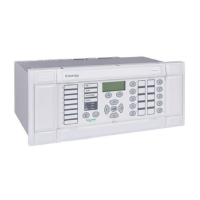P54x/EN CM/La4 Commissioning
(CM) 10-12
MiCOM P543, P544, P545 & P546
CM
As the P54x relies on voltage memories and delta step changes as would happen on a real
power system, certain functions within the relay must be disabled or bypassed to allow
injection testing. Selecting the Static Mode test option serves to bypass the delta phase
selectors, and power swing detection.
For the tests, the delta directional line is also replaced by a conventional distance directional
line, and the digital filtering slows to use a fixed one cycle window. Memory polarizing is
replaced by cross-polarizing from unfaulted phases.
The Static Test mode allows older injection test sets to be retained, and used to commission
and test the P54x.
Note: Trip times may be up to ½ cycle longer when tested in the static
mode, due to the nature of the test voltage and current, and the
slower filtering. This is normal, and perfectly acceptable.
2.12 Loopback mode
If the P54x relay is
used as a current differential relay, i.e. [090F Phase Diff] within [09
CONFIGURATION] is enabled, the loopback test facilities provide to the user with the ability
to check the current differential protection. On the other hand, if the P54x relay is not used
as a current differential relay, i.e. [090F Phase Diff] is disabled and [0941 InterMiCOM
64
Fiber] is enabled within [09 CONFIGURATION], the loopback test facilities, provide to the
user with the ability to check the InterMiCOM
64
signaling.
Note: Selecting the [0F13 Loopback Mode] to Internal, only the internal
software of the relay is checked whereas External will check both the
software and hardware.
When the relay is switched into either ‘Loopback Mode’, the relay will automatically use
generic addresses (address 0-0) and will respond as if it is connected to a remote relay with
the current at the remote end equal to and in phase with the current injected at the local end.
The signals sent and received (IM64) continue to be routed to and from the signals defined
in the programmable logic.
2.13 IM64 test pattern
The [0F
14 IM64Test Pattern] cell is used in conjunction with the [IM64 Test Mode] cell to set
a 16-bit pattern (8 bits per channel) that is transmitted by the InterMiCOM
64
message whilst
ever the ‘IM64 Test Mode’ cell is set to ‘Enable’. The ‘IM64 Test Pattern’ cell has a binary
string with one bit for each User Defined Inter-Relay Commands which can be set to ‘1’ to
operate the IM64 output under test conditions and ‘0’ to not operate it.
2.14 IM64 test mode
Whe
n the Enable command in this cell [0F15] is issued, the InterMiCOM
64
commands
change to reflect the state to the values set in the ‘IM64 Test Pattern’ cell. If set to ‘Disable’,
the InterMiCOM
64
commands reflect the state of the signals generated by the protection and
control functionality of the relay.
2.15 Using a monitor/download port test box
A monito
r/download port test box containing 8 LED’s and a switchable audible indicator is
available. It is housed in a small plastic box with a 25-pin male D-connector that plugs
directly into the relay’s monitor/download port. There is also a 25-pin female D-connector
which allows other connections to be made to the monitor/download port whilst the
monitor/download port test box is in place.
Each LED corresponds to one of the monitor bit pins on the monitor/download port with
‘Monitor Bit 1’ being on the left hand side when viewing from the front of the relay. The
audible indicator can either be selected to sound if a voltage appears any of the eight
monitor pins or remain silent so that indication of state is by LED alone.

